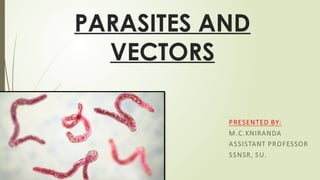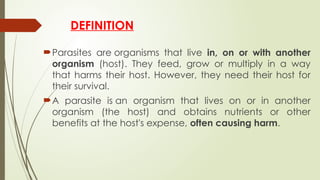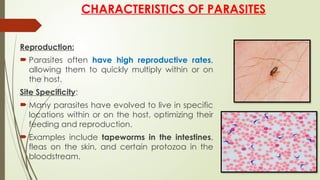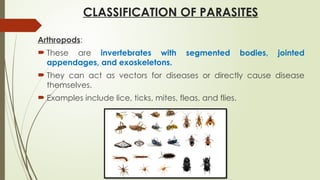parasites/parasite in microbiology .pptx
- 2. INTRODUCTION 1. A parasite is an organism that lives on or in another organism, the host, and gets its food from it. Parasites can cause disease in humans. E.g. Protozoa 2. A vector is a living organism that transmits a disease- causing agent (pathogen) from one organism to another. E.g. parasites, bacteria, viruses, or other microorganisms
- 3. DEFINITION Parasites are organisms that live in, on or with another organism (host). They feed, grow or multiply in a way that harms their host. However, they need their host for their survival. A parasite is an organism that lives on or in another organism (the host) and obtains nutrients or other benefits at the host's expense, often causing harm.
- 4. CHARACTERISTICS OF PARASITES Host Dependence: Parasites rely on a host organism for survival, reproduction, and obtaining nutrients. Without a host, many parasites cannot survive and reproduce. Size and Host Relationship: Parasites are typically smaller than their hosts. This size difference allows them to live within or on the host for extended periods without necessarily causing immediate death.
- 5. Reproduction: Parasites often have high reproductive rates, allowing them to quickly multiply within or on the host. Site Specificity: Many parasites have evolved to live in specific locations within or on the host, optimizing their feeding and reproduction. Examples include tapeworms in the intestines, fleas on the skin, and certain protozoa in the bloodstream. CHARACTERISTICS OF PARASITES
- 6. Immune System Evasion: Parasites have developed strategies to evade the host's immune system, by hiding in immune-privileged sites, varying surface antigens, modulating the host's immune response, and even directly attacking immune cells. These strategies allow them to survive and reproduce despite the host's defenses. CHARACTERISTICS OF PARASITES
- 7. Harm to the Host: While parasites don't always kill their hosts, they can negatively impact their health. This harm can manifest in various ways, including disease, malnutrition, weakened immunity, and behavioral changes. CHARACTERISTICS OF PARASITES
- 8. CLASSIFICATION OF PARASITES Parasites are broadly classified into two main groups: ENDOPARASITES (living inside the host) ECTOPARASITES (living on the surface of the host)
- 9. Within these categories, parasites can be further divided into three primary groups: 1. protozoa, 2. helminths, and 3. arthropods. CLASSIFICATION OF PARASITES
- 10. Protozoa: These are single-celled eukaryotic organisms. They can be found in various locations within the body, including the intestines, blood, and tissues. Examples include Giardia, Cryptosporidium, and Plasmodium. CLASSIFICATION OF PARASITES
- 11. Helminths (Worms): These are multicellular, parasitic worms. They are often found in the gastrointestinal tract. Examples include roundworms (nematodes), tapeworms (cestodes), and flukes (trematodes). CLASSIFICATION OF PARASITES
- 12. Arthropods: These are invertebrates with segmented bodies, jointed appendages, and exoskeletons. They can act as vectors for diseases or directly cause disease themselves. Examples include lice, ticks, mites, fleas, and flies. CLASSIFICATION OF PARASITES












